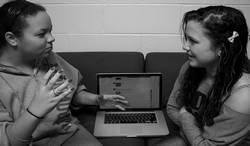Counseling and Psychological Services held a meeting called “How to Talk to Your Roommate” that provided communication tips for residents at the University.
The event gave students the opportunity to explain the problems they encountered while living with different individuals and how they should use communication to fix these issues.
“This is an attempt to get students to be aware of and use certain skills that can resolve some roommate conflicts, before they become a big deal,” said Tom McCarthy, the psychological counselor that held the meeting.
McCarthy began his discussion by asking the students what types of conflicts they faced while living with someone new. The students mentioned many problems which included sharing, overnight guests, personal space, personality differences and partying.
The students were asked about the differences between communicating and talking. Talking is when an individual hears what another is saying but does not necessarily understand, while communicating involves actively listening by giving eye contact, feedback, and responding to what the individual is saying, according to McCarthy and different students at the meeting.
McCarthy said examples of feedback include a head nod or even just the inaudible sound of “mhm.” He said the way to actively listen is by “putting yourself in their shoes” and being able to relate to what a person is saying.
“I believe that the biggest problem facing students who live on campus pertains to communication,” said Chris McKittrick, a residence hall director at the University. “Most roommate conflicts originate from either a lack of communication or miscommunication.”
“IDEAS” is an acronym explained by McCarthy that is an easy way to remember problem-solving models to use with a roommate.
The “I” stands for identifying the problem. This means to be as specific as possible and, since people interpret things differently, individuals must figure out what exactly it is that needs to be fixed.
The “D” represents defining possible, alternative solutions. This means that the people involved in the conflict must brainstorm and generate as many possible solutions to the problem at hand.
“E” is for evaluating the alternative solutions and picking one that is mutually accepted and is also a compromise on all parts.
“A” stands for analyzing the preferred solution or basically checking to make sure that there are no problems with your compromise. With this step, a person should also figure out who to talk to if there are any problems.
Michael Palardy, a resident assistant (RA) at the University said, “Don’t be afraid to go to your RA.” Palardy wants people to feel comfortable confiding in RAs when there is a roommate issue because they can help find the best solution.
The last step is “S,” which means to stick with it. This step focuses on making a conscious effort to stick with the decision, trying to resolve the problem and maintaining a beneficial solution.
One key thing to remember while trying to solve a problem is that it is not a competition. According to the participants and faculty at the meeting, an individual must not attempt to win an argument, but instead he or she should always try to compromise.
“Always give your roommate the benefit of the doubt,” said Kelsey Rinear, a participant at the meeting. Rinear said that you should not judge your roommate, but instead try to understand them.
Counseling and Psychological Services offers many other workshops that help with student-related problems, such as sexual assault, eating disorders, bereavement, LBGT and crisis talks to name a few.
PHOTO COURTESY of Kim Grier



